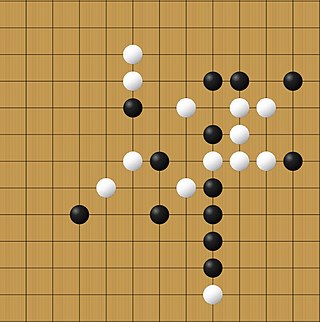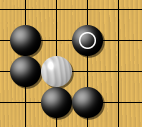
Atari is a brand name that has been owned by several entities since its inception in 1972. It is currently owned by French company Atari SA through a subsidiary named Atari Interactive. The original Atari, Inc., founded in Sunnyvale, California, USA in 1972 by Nolan Bushnell and Ted Dabney, was a pioneer in arcade games, home video game consoles, and home computers. The company's products, such as Pong and the Atari 2600, helped define the electronic entertainment industry from the 1970s to the mid-1980s.

Gomoku, also called Five in a Row, is an abstract strategy board game. It is traditionally played with Go pieces on a 15×15 Go board while in the past a 19×19 board was standard. Because pieces are typically not moved or removed from the board, gomoku may also be played as a paper-and-pencil game. The game is known in several countries under different names.

Pente is an abstract strategy board game for two or more players, created in 1977 by Gary Gabrel. A member of the m,n,k game family, Pente stands out for its custodial capture mechanic, which allows players to "sandwich" pairs of stones and capture them by flanking them on either side. This changes the overall tactical assessments players face when compared to pure placement m,n,k games such as Gomoku.
The video game crash of 1983 was a large-scale recession in the video game industry that occurred from 1983 to 1985, primarily in the United States. The crash was attributed to several factors, including market saturation in the number of video game consoles and available games, many of which were of poor quality. Waning interest in console games in favor of personal computers also played a role. Home video game revenue peaked at around $3.2 billion in 1983, then fell to around $100 million by 1985. The crash abruptly ended what is retrospectively considered the second generation of console video gaming in North America. To a lesser extent, the arcade video game market also weakened as the golden age of arcade video games came to an end.

Go is an abstract strategy board game for two players in which the aim is to surround more territory than the opponent. The game was invented in China more than 4,500 years ago and is believed to be the oldest board game continuously played to the present day. A 2016 survey by the International Go Federation's 75 member nations found that there are over 46 million people worldwide who know how to play Go, and over 20 million current players, the majority of whom live in East Asia.

The rules of Go have seen some variation over time and from place to place. This article discusses those sets of rules broadly similar to the ones currently in use in East Asia. Even among these, there is a degree of variation.

Computer Go is the field of artificial intelligence (AI) dedicated to creating a computer program that plays the traditional board game Go. The field is sharply divided into two eras. Before 2015, the programs of the era were weak. The best efforts of the 1980s and 1990s produced only AIs that could be defeated by beginners, and AIs of the early 2000s were intermediate level at best. Professionals could defeat these programs even given handicaps of 10+ stones in favor of the AI. Many of the algorithms such as alpha-beta minimax that performed well as AIs for checkers and chess fell apart on Go's 19x19 board, as there were too many branching possibilities to consider. Creation of a human professional quality program with the techniques and hardware of the time was out of reach. Some AI researchers speculated that the problem was unsolvable without creation of human-like AI.

Life and death (死活) is a fundamental concept in the game of Go, where the status of a distinct group of stones is determined as either being "alive", where they may remain on the board indefinitely, or "dead", where the group will be lost as "captured". The basic idea can be summarized by:
In tabletop games and video games, game mechanics are the rules or ludemes that govern and guide the player's actions, as well as the game's response to them. A rule is an instruction on how to play, a ludeme is an element of play like the L-shaped move of the knight in chess. A game's mechanics thus effectively specify how the game will work for the people who play it.

Swordquest is a series of video games originally produced by Atari, Inc. in the 1980s as part of a contest, consisting of three finished games, Earthworld, Fireworld, and Waterworld, and a planned fourth game, Airworld.

There are many variations of the simple rules of Go. Some are ancient digressions, while other are modern deviations. They are often side events at tournaments, for example, the U.S. Go Congress holds a "Crazy Go" event every year.

In the game of Go, shape describes the positional qualities of a group of stones. Descriptions of shapes in go revolve around how well a group creates or removes life and territory. Good shape can refer to the efficient use of stones in outlining territory, the strength of a group in a prospective fight, or making eye shapes so that a group may live. Bad shapes are inefficient in outlining territory and are heavy. Heavy groups cannot easily make eye shapes and are therefore good targets for attack. Understanding and recognizing the difference between good shape and bad is an essential step in becoming a stronger player.
In the game of Go, a ladder,(征子) is a basic sequence of moves in which an attacker pursues a group in atari in a zig-zag pattern across the board. If there are no intervening stones, the group will hit the edge of the board and be captured.

Atari, Inc. was an American video game developer and home computer company founded in 1972 by Nolan Bushnell and Ted Dabney. Atari was a key player in the formation of the video arcade and video game industry.

Superman is a video game programmed by John Dunn for the Atari Video Computer System and released in 1979 by Atari, Inc. The player controls Superman, whose quest is to explore an open-ended environment to find three pieces of a bridge that was destroyed by Lex Luthor, capture Luthor and his criminal gang, and return to the Daily Planet building. The game world is populated by antagonists such as a helicopter that re-arranges the bridge pieces and roving kryptonite satellites that cause Superman to revert into Clark Kent.

Ghostbusters: The Video Game is a 2009 action-adventure game based on the Ghostbusters media franchise. Terminal Reality developed the Windows, PlayStation 3, and Xbox 360 versions, while Red Fly Studio developed the PlayStation 2, PlayStation Portable, and Wii versions. The game was released after several delays in development and multiple publisher changes. In North America, all versions of the game were published by Atari Interactive, while in Europe, the PlayStation 2, PlayStation Portable, and PlayStation 3 versions were published by Sony Computer Entertainment Europe. A separate game for the Nintendo DS with the same title was developed by Zen Studios and released at the same time, albeit with substantial differences in the gameplay and story.

AlphaZero is a computer program developed by artificial intelligence research company DeepMind to master the games of chess, shogi and go. This algorithm uses an approach similar to AlphaGo Zero.

MuZero is a computer program developed by artificial intelligence research company DeepMind to master games without knowing their rules. Its release in 2019 included benchmarks of its performance in go, chess, shogi, and a standard suite of Atari games. The algorithm uses an approach similar to AlphaZero. It matched AlphaZero's performance in chess and shogi, improved on its performance in Go, and improved on the state of the art in mastering a suite of 57 Atari games, a visually-complex domain.










